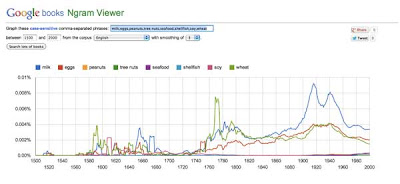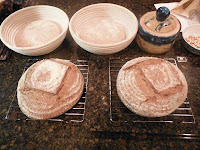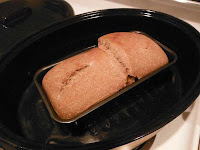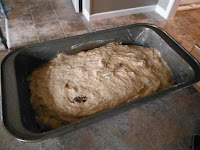Same good taste, same moistness, but it wasn't proofed long enough in the fridge, and the top blew apart during baking.
I. Gluten Free?
These days it is seen to be fashionable to be 'gluten free'. I personally believe that this trend does not necessarily reflect what wheat allergies are present in our population (or even wheat sensitivities or wheat immune responses), it represents a trendiness among people who think about food and who are concerned with what they eat.
A couple of articles have drawn this to my attention. The first is a report by someone named
Dr. Murray of the Mayo Clinic Research team, who has determined that celiac disease is on the rise. It is even as much as 4 times as prevalent as it was in the 1950's. While Murray stops short of blaming the wheat that is now commonly grown, he does indicate it suggests the increase in the disease is due to something in our environment.
The other article is from
Prevention Magazine, which also quotes the same study performed by someone named Joseph Murray MD, a Mayo Clinic gastroenterologist. Murray is further quoted, and the gist of the article is that celiac disease, and gluten sensitivity, is on the rise, but is under-diagnosed because many people are going gluten-free without getting properly tested. This article urges people to get tested if they have suspicions, but not to avoid gluten on a whim or because some celebrity has lost weight when they go on this diet. Prevention Magazine (the hard-copy of the mag, which some nurse left in our lounge) comes to the conclusion that many people are on this diet who do not need to be.
And then again, I read the liner notes (and some of the website linked to) from the interesting YouTube video put out by someone called Dr. Osborne, who has created a website and clinic called the Glutenology Clinic. Their poster child is a young patient named Michael, who was diagnosed with "non-celiac gluten sensitivity," a condition that is under-diagnosed, on the rise, and clearly debilitating. A gluten-free diet saved his life. Dr. Osborne says, pointedly, "does this sound like a diet trend?" Osborne appears to be against eating grain of any kind, and gives compelling reasons why (example: its the prolamins -- if you are sensitive to any grain's prolamin, you may be sensitive to any grain's prolamin). At the same time, he gives dietary advice (here's a link to their
cookbook) about how to safely eliminate grain from the diet entirely.
As I've said before, the neolithic dieters also say that all grain should be avoided. So is a gluten-free, grain-free diet, a fashionable trend or is it a reflection of a real need?
Daniel Engber**, writing for Science, on Slate.com has tracked the origin of the trend to Elisabeth Hasselbeck, a host on 'The View' who has written books on going wheat free.
You have to be careful when you suggest that the increase of the prevalence of an actual disease might be merely the result of a meme. Witness the outcry of those who have
Morgellons Disease (which is usually diagnosed as an illness with a strong psychogenic component): when they were told by
Lustig and
Freudenreich in
Psycosomatics magazine that the rise in Morgellon's rate of incidence is due to the fact that it has become an Internet meme (Pulman went so far as to call Morgellon's Syndrome in the Journal of Medical Internet Research "
Munchausen by Internet"), those who actually suffer from this disease (some even call themselves "
morgies") went ballistic on several web forums. Diagnosing the increase in disease prevalence as meme-driven doesn't stop the meme.
Let's go on record here and say that celiac disease is real, gluten intolerance is real, gluten sensitivities are real, and they are on the rise. But I still suspect that most of the rise is due to a fashionable trend.
The real figures for Celiac Disease are still somewhere around 1% of the population. That's high, of course, and it seems to be getting higher.
Braly and Hagan in their book "Dangerous Grains" suggest that gluten sensitivity is 30 times more prevalent than celiac disease, and that 15% of all humans are gluten sensitive. Not sure if that's true (even if it is, it means most of us still are not). But how do we know if something is really happening, or if it is all just a trend?
II. The Connection to Modified Wheat
Most of the books and articles I've read that advise a gluten-free diet suggest that the wheat we consume today is modified, and this modification is causing a greater immune response or allergic reaction in our general population. But nowhere could I find out precisely what the changes have been to our wheat that would have caused this increased allergic reaction -- or even if it is true that we are, on the whole, reacting more to it.
While I have been taking a break from blogging, I've been trying to research the genetic changes in our wheat, and I expect to write about this in the next few blog postings, as I get up and running again. I haven't been able to find out much about how the changes have affected our health. The studies simply are not there.
III. Charting allergies with Ngrams
For today's blog, I have been playing with
Google's Ngram Viewer, using it as a tool to investigate whether the increased rate of gluten problems that the trend-setters have identified are substantive.
Google Ngram Viewer is an online visual instrument that scours the scanned corpus of the world's books for the words and phrases you provide, and then it charts the trends. The result gives you an idea of how frequently a phrase or a word is used in books. By comparing several words or phrases, you can get an inkling into the concerns we have as a species. It is a rough index of our attention.
IV. The Big 8 Allergens
Let's try out Google's Ngram Viewer with a simple example. Wikipedia's article on
food allergies identifies the top 8 foods that cause allergic reactions as the 'Big 8':
milk, eggs, peanuts, tree nuts, seafood, shellfish, soy, wheat. When one inputs these nouns into the Google Ngram Viewer, with an extra long time period, we can see which of these foods has commanded more of our attention.
.jpg) |
Click on these ngram snapsnots to take a closer look at any of them.
This is a graph of how often we mention 8 common foods, from 1500-present. |
What can this graph tell us? Well, the one fact that leaps out to me -- when you chart these foods on a timeline from 1500 to the present era -- you see two or three of these foods dominate our attention: milk, eggs, and wheat. Of the "big 8", these are the "big 3." There are also a few peaks, of when certain of the foods are popular. More on this later.
Now lets compare that chart to the one created if we add the word 'allergy' to each food item: '
milk allergy, egg allergy, peanut allergy…' etc. You find that the allergies only get talked about since 1880, and then there is a jump in the 1920s, and the trend is thereafter upward. Because allergies have mostly only been discussed in our literature since the 20's, we can therefore zoom in on this timeframe for a closer look:
 |
| Big 8 Allergies |
The resulting graph tells us where and when the allergic reactions became a concern for us -- i.e. when we became aware of the allergy, and when we had something to say about it. It is, therefore, a rough guide to when something happened, and how often something happens (there is a caveat: I am only checking ngrams on English words, so I'm not really charting world-wide trends).
V. Big 3 Foodstuffs
Let's see what else we can find when we play with the Google ngram viewer a little bit.
If we chart only the foods of the 'Big 8' themselves from 1920 on, the trend is to
talk less and less about all these foods (presumably we don't need to talk about them much, because we have enough food during this time period). Notice that during the years of the second world war our interest in milk waxed briefly. My theory is the graph shows us that when talk about food spikes dramatically, we as a species are probably experiencing food shortages or food concerns, and we are trying to deal with it using technological and biological innovation.
If you go back and take a look at the first chart, of the 'big 8' foods since Gutenberg gave us shareable books, the ngram of these 8 foods shows that our interest in wheat spiked around 1580-1610, again around 1770, and again briefly at 1790. In the years 1650-1680, milk became more important to us; it happened again in 1780 for a while, and then finally around 1850 milk became more talked-about than wheat, presumably forever. It is dangerous to conjecture on the reasons behind this, but I suspect that this reflects changes in milk production and delivery, based on new technologies that caught our attention, and we began to use it more. We are also using milk colloquially -- we are milking it for all its worth.
VI. Allergic Trends: Nuts and the 'Big 4'
So far, we've mostly only looked at the foods themselves. Now let's look more closely at how much we've had to say about allergies to these foods. The most obvious trend is that all allergies are on the rise, but that milk allergies far outstrip all other allergies in rate of talk, and in the amount of talk about them. Egg allergies come second, and wheat, third -- at least until about 1992, when peanut allergies spiked and became the most rapidly growing allergen talked about yet.
 |
| Milk allergies are the most talked about allergies from 1920 on |
If you look at the trends more closely, on a different scale, you can see that peanut allergies actually overtook milk allergies in mentionability in 2007. Wheat allergies and egg allergies are pretty much flatlined, and milk allergies are dropping a bit, based on how much we talk about them. But now peanuts as an allergen are more important to our literature, and the "big 3" has become a "big 4." The other allergens -- soy, seafood, shellfish, and tree nuts -- remain less interesting to us. However, it occurred to me that no one in English uses the phrase "tree nut." I performed a few specific searches for specific nuts and nut allergies, and it would seem that, along with peanuts, allergies for other nuts are on the rise and have surpassed the discussion of wheat allergies just recently. Perhaps this is because peanut allergies cause such a quick and dangerous immune response, and there have been many deaths. A lot of mystery writers add peanut allergies to their victims, just for fun.
 |
| Peanut allergies are the most talked about allergy after 2007 |
You can't tell me that Neolithic hunter gatherers were not eating nuts. Maybe they were not eating grains in the quantities we do today, but they were eating nuts, and probably more than we do today. Acorns, after all, were a staple before there was bread. But no one seems to be saying that nuts are more allergic today because they are genetically modified. Why is wheat singled out with this accusation?
VII. Celiac Disease/Gluten Allergies/Sensitivities/Intolerance
All of this playing with data proves nothing, of course. But I find it interesting. If milk allergies and peanut allergies are the reactions that have been more widely talked about in our book-literature, where is all this trend about increased wheat allergies, and gluten sensitivities coming from?
Now, just as we don't say 'tree nut allergy', we rarely talk about 'wheat sensitivity' but more often call it 'gluten sensitivity'. Compare these two ngrams, from 1950 on:
 |
wheat allergy, wheat sensitivity, wheat intolerance, reaction to wheat:
Wheat allergies are on the rise |
 |
gluten allergy, gluten sensitivity, gluten intolerance, reaction to gluten:
Gluten sensitivities and Gluten intolerance is on the rise |
Celiac disease is mentioned in our books from about 1900 on. But when you chart celiac disease against wheat or gluten allergy, sensitivity, intolerance, or reaction (the two charts above), the actual use of celiac disease dwarfs the other words into insignificance:
 |
Mention of Celiac Disease dwarfs all other mentions of Wheat or Gluten sensitivities:
But it is not unequivocally on the rise |
VIII. Name it, Adam; You have to Live With It.
In science, once something is named, we can talk about it. Google Ngram Viewer tells us at a glance that
allergies were not mentioned before 1900. Wikipedia says the word was coined by Clemens Von Pirquet in 1906, so that explains it.
Celiac disease, although old, was really brought to the attention of the western world in 1856, when Francis Adams translated an old text -- and it is talked about after that.
The word
gluten is
very old, however. As early as 1510* it appears in our English books; and around 1850 and 1920 it was used far more than it is today. Gluten was always used in English contexts for the agglutinating albumin-like properties of crushed grains, and thus it does not specifically refer to wheat (although in common usage, the identification of gluten and wheat is clear). Anyone who has eaten porridge will appreciate the gluiness of it. That gluiness comes from the gluten, whether it is oatmeal, rice, or some other grain. We don't eat much wheat porridge any more. We once did, and we knew it was gluey. Wheat paste has been used in the production of paper and books for a long time, so its gluten has been talked about since books became important.
Even the word
gliadin (the prolamin in wheat gluten that has been identified as the culprit in celiac disease) is old. This substance was identified long ago by our first chemists. But it is only since the 1820s that it is more commonly used in our literature.
On celiac-support web sites you often find discussions about which grains contain gluten, and which might be safe to use. Oats are a familiar topic, because often some people with celiac disease or wheat sensitivities can't tolerate oats either. There are suspicions that oats are stored or processed in mills that also do wheat, and this is the cause of the trouble for celiacs. Because of this, some Oats suppliers are selling their oats as 'Gluten Free', because they are not processed in facilities that mill other grains.
Prolamins
However all grains contain gluten, in the old sense of the word. Most grains have specific names for their agglutenous proteins. These are the proteins that cause the most allergic reactions and sensitivities in humans. It has been discovered that these proteins all have a high
proline and
glutamine content, and the class of plant storage proteins has been called
prolamins. Each grain has its own specific prolamin; but some grains (e.g. teff) are just beginning to have their proteins explored, so all of the prolamins are still in the process of being named. Of the following list, currently
panicin and
orzenin are new enough that they can't even be found in Google's Ngram viewer;
penniseiten hasn't even got too many hits in Google, and none yet in Google Scholar (one article I read by scientists who studied teff's prolamin didn't even name it, so I don't know who actually named penniseiten -- perhaps someone 'out there' can tell me). Hordein has been around much longer, of course, as it has long been important in brewing beer.
| Grain | Prolamin | % of protein |
| Wheat | gliadin | 69% |
| Corn | zien | 55% |
| Barley | hordein | 52% |
| Sorghum | kafirin | 52% |
| Rye | secalin | 50% |
| Millet | panicin | 40% |
| Oats | avenin | 16% |
| Teff | penniseiten | 11% |
| Rice | orzenin | 5% |
Do all people get an immune response from some or all of these prolamins? No. Is it true that some people do? Yes. How many? Less than those afflicted with Celiac Disease, so less than 0.5-1.0% of the population.
Wikipedia quotes a study that pegs it at 0.21%. Peanut allergies are somewhere around 1%, according to the Wiki, but the rise in peanut allergies reported may be out of proportion to the actual number. The same Wiki says that there is a mass
psychogenic component to peanut allergies. There are more than double the number of people with seafood allergies than peanut allergies, but we talk more about peanut allergies, we worry about it more. If one could draw a cause-effect link, it would be obvious that all this talk about peanut allergies is making us sicker.
The same thing might be happening with our brooding over gluten sensitivities. For some unfortunate people, it is real, it is a hardship they must bear. For the rest of us -- most of us -- it is a fad. It has become fashionable to go 'gluten free'. The food prep industry is aware of this trend and is using it to sell to us.
The more we talk about it, the more we notice it.

































































.jpg)

.jpg)







